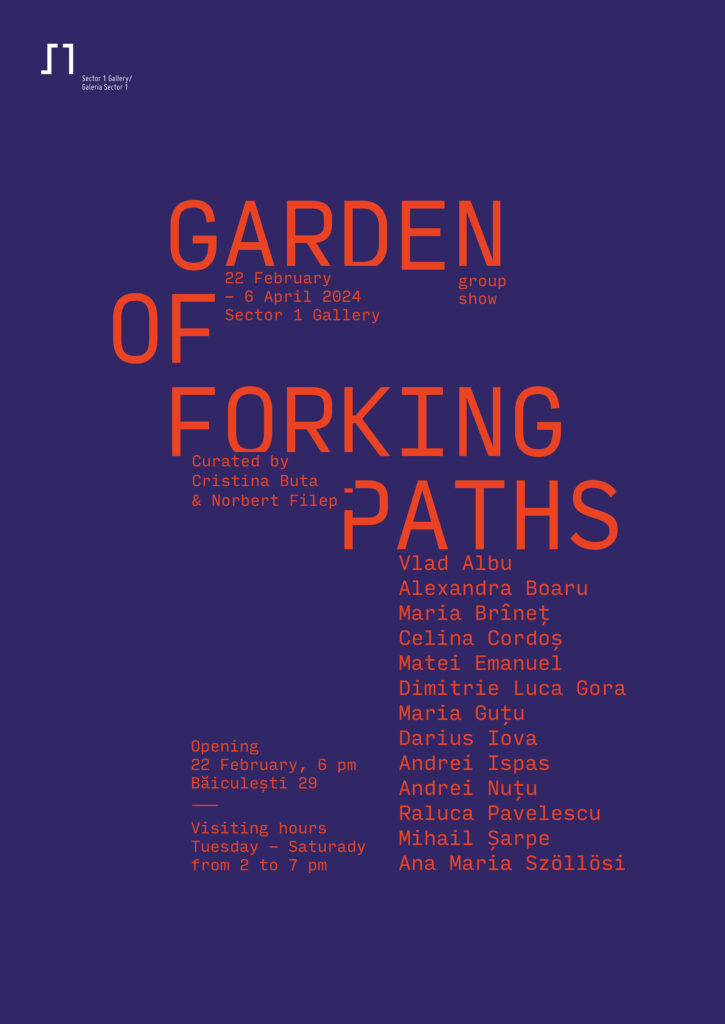Garden Of The Forking Paths
22th February - 6th April 2024
Artists: Vlad Albu, Alexandra Boaru, Maria Brinet, Celina Cordos, Matei Emanuel, Dimitrie Luca Gora, Maria Gutu, Darius Iova, Andrei Ispas, Andrei Nutu, Raluca Pavelescu, Mihail Sarpe, Ana Maria Szollosi
Curated by: Cristina Buta & Norbert Filep
Location: Sector 1 Gallery (29 Baiculesti Street, Bucharest, Romania)
Garden of Forking Paths brings together 13 emerging artists belonging to a newer generation, working across different regions in Romania, and the Republic of Moldova. In their practices, intimacy, memory, spatiality, social critique and humour play an important role.
Engaging in different explorations and instances of emotion translated through various mediums, these artists involve affect in their universe of creation. Drawing its title from the short story “The Garden of Forking Paths” by Jorge Luis Borges, the exhibition proposes to explore the many-worlds in their body of work tapping into a miscellaneous network of approaches and references ranging from popular culture to medieval history, AI or the subconscious. In each of their “gardens”, a particular story is told, from a different perspective, mapping trajectories of inquiry into conventionality and contesting the particular way in which systems of perception come to being.
Vlad Albu (b. 1992) often combines photography, found materials, and designed structures/objects in his practice. His works are focused on exploring the intersection between public and private spaces, methods of understanding the future of objects and dwelling with a deliberate blend of speculative elements and imaginative narratives. Some of the questions that he poses in the works from this exhibition are: When materials merge into new entities, what novel properties emerge from their convergence? Can the process be controlled and engineered to achieve specific outcomes, or does it introduce unpredictability and useless complexity?
Alexandra Boaru is a multi-media artist, whose practice challenges the concept of ”human’ ‘and its impact on the exterior, others or herself. One of the main themes seen throughout her artworks is the exploration of boundaries between being human and becoming something else.
In the installation presenting a series of self-portraits, titled My limbs are not long enough and the angles they form I wish they were sharper, Alexandra is guiding her body with the use of sticks and branches gathered from the forest, resulting in strange and often uncomfortable, almost sculptural poses. The body is no longer soft flesh; it does not belong anymore in the realm of the “conventional human”, it gives way to a natural cyborg with sticks and stones.
Maria Brîneț is an artist working in Cluj-Napoca. She mainly employs sculpture and installation in her artistic practice, as well as contemporary and classical techniques. Questioning and reinterpreting subjective or collective archives, she interrogates the way in which we can use the value of some imperceptible aspects, which incorporate memory, trauma or the imperceptible transition from one generation to another. The work The Suitcase illustrates the relationship between owner and property, the housing crisis and the construction of a home, hinting to the artist parents’ multiple attempts to establish a home.
As an artist, Celina Cordoș (n. 1994) assumes the role of a voyeur, tackling intimate subjects
through which she captures more than an action of habit; rather, pendulating between oniric and real. Her monochromatic works become the playground where any or all borders between techniques disappear, granting her the freedom to combine different types of materials in the constant pursuit of capturing the exact mood or atmosphere that the viewer is meant to experience.
Matei Emanuel is an emerging visual artist whose artistic practice involves formulating social ironies through objects made from various materials and techniques. The artist aims to introduce works with mass-produced aesthetics into an art world where sophisticated values and expectations discredit the appreciation of a comic attitude. Adam and Eve consists of two apparently identical fragments of a corsage, a didactic tool for the study of musculature. Shapes representing genitalia or sexualized body parts can be placed on these torsos, reproducing the shape of emojis from the virtual space of social networks. The playful assemblage poses questions on various topics – gender binarity and the way in which the human body is studied from an anatomical point of view, and at the same time the impulse to standardize and objectify sexualized organs.
Dimitrie Luca Gora is an artist and student in Bucharest. As an artist, he explores a variety of forms of expression, including photography, videography, installation, painting and sculpture. In works such as MacGas or Brave Pikachu, the artist brings images that compose “national identity” into the space of contemporary art. With nostalgia and irony, these common images of ready-mades from post-communist childhood come to have a new life, seen through the artist’s personal filter. “I am very curious where they will end up. How will the stove and the duckling of my childhood find their place in the story of global warming, war or the loss of innocence? Who will win, nostalgia or irony?”
Maria Guțu (b. 1996) is particularly interested in documentary photography, portraiture, rural space and the connection between man and his environment. The photographs in the exhibition are part of the long-term project Gumka (Russian: Secondhand), in which the artist researches and documents the “Lokomotiv” flea market in the city of Chisinau.
Darius Iova (b. 2000) uses the digital image as a means of expressing his artistic pursuits, addressing topics such as personal identity or memory. “Frame picture of a bad memory” is a series of works created in collaboration with artificial intelligence, which analyzes the phenomenon of false memories, illustrating possible variants of some memories. Compositions depicting anatomical anomalies, almost abstract, characteristically aggressive and strange, are the result of what the algorithm actually does not know, a misinterpretation of a command and the mimicking of a kind of autonomy.
Based on photographs and memory, the landscapes and interiors of Andrei Ispas (n. 1994) are not representations of topographically defined spaces, nor do they document a monocular photographic snapshot in oil colour. Rather than these frivolous and fashionable procedures, they invite us into landscapes drawn from personal or collective memory, finished for the most part in a carefree, almost offhand manner. Informed by the history of early modernist painting, these works present the Romanian cultural landscape; the changing urban and rural landscape, figures engaged in mundane actions, or simply the timelessness of the perpetual organic world.
The works of Andrei Nuțu (b.1996) aim to capture our deeply human and ephemeral experiences, and, above all, to illustrate not only what is in the foreground, but also what, often involuntarily, remains outside the story. His study during the last years, of fresco painting from various geographical areas and historical periods is reflected in his practice. While Post Oneiric Blues refers to the dream of Claudia, Pilat’s wife, and conveys a sense of ambiguity, Ecce homo is based on a detail from a painting by Rogier van der Weyden. The recontextualization of image, technique and name (interdependent and having completely different sources) converge in a new narrative thread. Influenced by the frescoes from Wallachia from the 14th-15th centuries, Burning martyr – the visual synthesis of a martyrdom, proposes a recontextualization of the Romanian medieval image in a contemporary setting.
Raluca Pavelescu (b. 2001) is a young artist who works in drawing, engraving and animation. A reflection on time and fragility, 30 seconds captures, frame by frame, the sequence between two acrobats trying to catch each other. Although the whole number lasts 30 seconds, and the moment of the fall is summed up in an interval of 2-5 seconds, we see time dilation in the face of imminent danger. The entire project focuses on the human perception of death materializing in the two characters at the barrier between life and death.
The creations of Mihail Șarpe (b. 1992) explore sculptural forms and structures in a simple and raw manner of the material. “I consider that the act of looking or contemplating represents the distinctive meaning in the works, thus the temporality of the structures is the reason for the subjective interpretation of what can be discerned by me as well as by the viewer.” The work “Untitled” evokes a diagonal/vertical presence in space, the 2 three-dimensional lines indicate a direction and ascent. At the same time, an attachment to the ground through the multiple extensions that are naturally tense and curved by the lines’ own weight. In the work “Transfer Series II” each of the segments presents a change in continuity, through the plastic deformation of the structure.
Often questioning her own psychology, Ana Maria Szöllösi (b. 1994) works with painting and drawing, using these mediums to transpose subconscious and personal memory elements into the spatial plane. Her works incorporate symbols that are clues to certain ideas captured within them. In Untitled, by depicting an empty, fragmented space, an atmosphere of transition infused with nostalgia is invoked. The work reflects the artist’s concerns of that period, which relate to social issues of instability and personal indecision. Vertigo sums up glimpses of distorted feelings or memories. Intense sensations seem to materialize on the canvas through the vibrant brush marks and atmospheric details.
Looking for more?
Address
Băiculești 29 Street, District 1, 013193, Bucharest, Romania
Opening Hours
Tuesday – Saturday, 2 – 7 PM
Sunday – Monday, by appointment only
Newsletter
Sign up to receive the latest news on the gallery’s artists
Sector 1 Gallery © 2023. All Rights Reserved.
Privacy Policy

